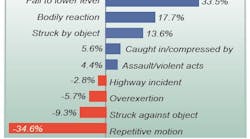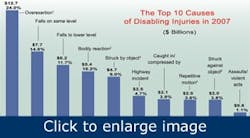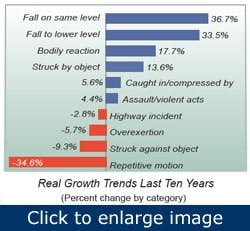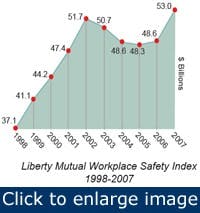Unions tout the benefits of safety training for members
Who is responsible for safety on the job site — individuals, the government, safety director, workers or all of the above? Everyone on a job site is responsible for safety. This simple, but often incorrectly answered, question is from a mini-quiz we’ve developed and distributed with weekly paychecks to remind members of the United Assn. (UA) workforce of top safety concerns.
MCA of Chicago offers safety training to member contractors through its Certified Safety Bureau, which includes both classroom training and online courses. Course offerings from the bureau include CPR and First Aid With Automated External Defibrillator (AED) Training; Asbestos Online Course; OSHA Online 10-Hour and 30-Hour Safety and Health; and Fall Protection.
United Assn., Local Union 597, boasts the largest learning facility for pipefitters in the United States. It includes virtual welding technology. Apprentices can practice welding with a heatless rod and watch a visual simulation while wearing a specially equipped welding helmet. The virtual welding is popular with young people who like video games, explains John Leen, training director of Local Union 597. “Students often use the system at lunchtime to work with it more,” he says. “Apprentices who practice with virtual welding learn more quickly than those who only do hands-on welding.”
That particular safety message is especially important. Effective workplace safety can be achieved only when everyone involved takes responsibility. Once they do, it’s easier for everyone to work together as a team and watch out for each other. That’s why the association, our member contractors and our union workforce, UA Local Union 597, stand together in our dedication to workplace safety training.
The most disabling workplace injuries and illnesses in 2007 amounted to more than $52 billion in workers’ compensation costs, according to the 2009 Liberty Mutual Workplace Safety Index. And according to the U.S. Bureau of Labor Statistics, workers in construction incurred the most fatalities of any private-sector industry during 2008, despite the fact that the number of construction fatalities that year declined 20% from the previous year — from 1,204 cases in 2007 to 969 cases.
“Safety must be a top priority on every job site,” says Dan Bulley, senior vice president of MCA of Chicago and head of its Safety Committee. “We don’t take chances with our workforce. Union safety training, in combination with the educational programs our association offers, provides our contractors and workers with the knowledge needed to work in optimal safety conditions.”
Research shows that union training in the construction industry provides more effective results than non-union programs. According to the study, “Building Trades Apprentice Training in Massachusetts: An Analysis of Union and Non-Union Programs, 1997-2007,” released by the Labor Resource Center of the University of Massachusetts in Boston, union apprenticeship programs graduate a higher percentage of journey-level workers.
The 10-year study compared union and non-union training programs in Massachusetts and found that union programs enroll the majority of building trade apprentices. The study also revealed that union programs are both larger and longer-lasting than non-union programs and are more successful at recruiting minorities and women.
Member contractor safety initiatives
[pullquote]Many member contractors of MCA of Chicago have initiated safety programs. Indiana-based BMW Constructors is a participant in OSHA’s Voluntary Protection Program (VPP). The VPP promotes optimal workplace safety and health. In this program, management, labor and OSHA establish a cooperative relationship to implement a comprehensive safety and health management system.
BMW Constructors dedicates itself to zero-injury performance. “Each of our workers is responsible for helping to eliminate the barriers that prevent us from achieving a zero-incident culture,” says Fred Bowers, director of environmental, health and safety with BMW. “All accidents are preventable. In the long run, safety takes priority over production, schedule and cost because you can’t buy back a worker’s lost life.”
AMS Mechanical Systems of Burr Ridge, Illinois, also has compiled its own zero-accident program. “The plan has really cut down on serious injuries,” says Mark Rook, safety director at AMS. “Our company’s safety philosophy is this: We have a moral obligation that workers leave each day the same or better than when they arrived that day. If they’re going to work for us, we’re going to protect them.”
AMS workers receive classroom training, job-site training and online classes on the basics, explains Rook. “Sitting a guy in front of a computer doesn’t compare to hands-on work with supervision,” he says. “We invest time and effort in our apprentices so they understand what they need and how to use it. First-year apprentices wear a green helmet so other workers will keep an eye out for them. It has worked out well for us — apprentice injuries don’t happen any more.”
And AMS job sites have a task-hazard analysis every morning, notes Rook. “All the workers have input,” he says. “We take a look at what tasks will be performed and analyze what hazards are associated with each. The analysis is now a requirement of AMS.”
AMS also investigates near-miss accident reports and discusses them with workers in weekly toolbox talks. “If something took place in the previous week, we talk about it,” says Rook.
Scheck Industries of Countryside, Illinois, has been recognized for its excellent ongoing safety record. In both 2008 and 2009, Scheck Industries was recognized by the Mechanical Contractors Association of America for its safety record: more than 1 million work hours each year with no lost work time.
“Those million-plus hours include projects with 400 to 500 workers,” says Joe Lasky, safety director at Scheck. “It takes a lot of training and cooperation to keep that many workers safe on the job site.”
Safety is so important to Scheck, it developed a workplace program called Job Aids for Working Safely (JAWS), which includes daily talks and other components to help keep workers aware of safety concerns. MCA of Chicago recognized Scheck with the Most Innovative Safety Program Award for the JAWS Program.
Scheck’s Employee Incentive Program gives safety points to workers for every hour worked safely. “We have a website where they can cash in their safety points and receive polo shirts, jackets, hunting jackets and other items,” explains Lasky. “It’s our way of providing reinforcement for workers who are accident-free.”
Teamwork is an essential part of workplace safety. That teamwork can be found in the collaboration between our association and our contractors and workers. It also can be found in the rapport between a member contractor, its workers and its clients.
Stephen Lamb is executive vice president of the Mechanical Contractors Association Chicago. Contact him at (312) 384.1220.



